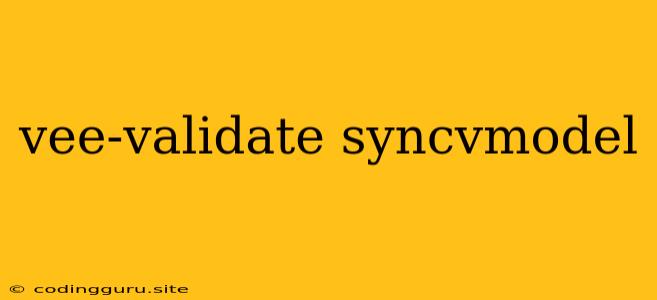Mastering Form Validation with Vee-Validate and syncVModel
Form validation is a crucial aspect of any web application. It ensures data integrity, improves user experience, and prevents errors. Vee-Validate is a popular validation library for Vue.js that offers a comprehensive set of features for seamlessly integrating validation into your applications.
One powerful feature of Vee-Validate is the syncVModel prop. This article will delve into the workings of syncVModel and explore its benefits for streamlining form validation within your Vue.js projects.
What is syncVModel in Vee-Validate?
syncVModel is a boolean prop that you can add to a Vee-Validate field component. When set to true, it establishes a two-way binding between the field's value and the Vue component's data property, enabling seamless data synchronization.
Why use syncVModel?
Here's why syncVModel is a valuable tool in your validation arsenal:
-
Simplified Data Flow: With
syncVModel, you eliminate the need for manual data management between your Vue component's data properties and the validation library. It automatically keeps the two synchronized, simplifying your code and reducing potential errors. -
Enhanced Reactivity: Changes made to the field's value are reflected in the corresponding data property and vice versa. This reactive nature makes it easier to update your form logic and UI based on validation state changes.
-
Improved User Experience: By providing real-time feedback on input fields,
syncVModelensures that users are immediately notified of any validation errors, allowing them to correct mistakes as they type. This contributes to a smoother and more user-friendly form experience.
How to use syncVModel
Let's illustrate how to use syncVModel with a practical example:
{{ errors[0] }}
In this example:
-
We use the
ValidationProvidercomponent to wrap our input field, defining the validation rules (required,min:3) and setting thesyncVModelprop totrue. -
The
v-modeldirective binds the input field's value to thenamedata property. -
Vee-Validate automatically synchronizes the input field's value with the
namedata property. -
The
v-ifdirective displays an error message if any validation errors occur.
With syncVModel, you achieve a seamless integration of validation into your Vue.js components, making form development smoother and more efficient.
Conclusion
Vee-Validate's syncVModel prop is a powerful feature that simplifies form validation by establishing a two-way binding between your Vue component's data and the validation library. It enhances reactivity, improves user experience, and makes form development more streamlined. By leveraging syncVModel, you can create robust and user-friendly forms with ease.
